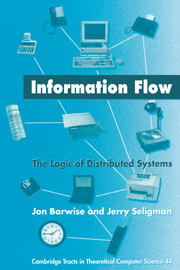3 - A Simple Distributed System
Published online by Cambridge University Press: 05 November 2011
Summary
In this lecture we investigate a distributed, physical system that is simple enough to explore in some detail but complex enough to illustrate some of the main points of the theory. Readers may work through this lecture as a way of getting a feeling for the motivations behind the mathematics that follow or skip ahead to the theory and come back to this example later. Readers who decide to work through this lecture should accept various assertions on faith, because they are justified by the work that follows.
Informal Description of the Circuit
The example consists of a light circuit LC. The circuit we have in mind is drawn from the home of one of the authors. It consists of a light bulb B connected to two switches, call them SW1 and SW2, one upstairs, the other downstairs. The downstairs switch is a simple toggle switch. If the bulb is on, then flipping switch SW2 turns it off; if it is off, then flipping SW2 turns it on. The upstairs switch SW1 is like SW2 except that it has a slider SL controlling the brightness of the bulb. Full up and the bulb is at maximum brightness (if lit at all); full down and the bulb is at twenty-five percent brightness, if lit, with the change in brightness being linear in between.
- Type
- Chapter
- Information
- Information FlowThe Logic of Distributed Systems, pp. 50 - 66Publisher: Cambridge University PressPrint publication year: 1997

